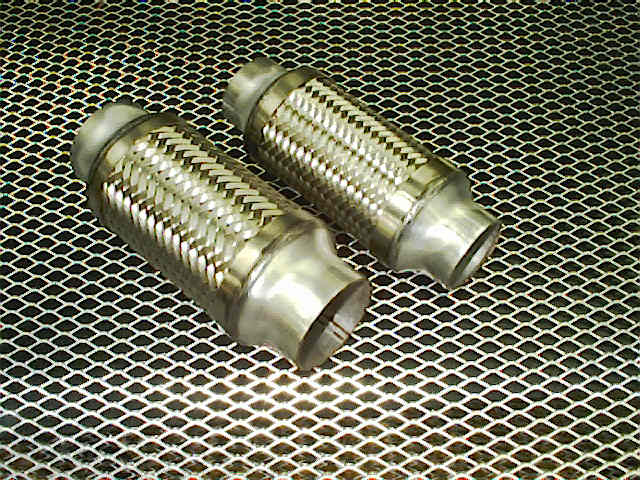Driving with a broken flex pipe is not only an unwise decision, but it can even turn out to be a fatal mistake. Hence, it is recommended to get it replaced as soon as you discover any related problem with your car.
You can also handle the issue yourself if you have the tools and parts required for the job.
1.What is a Flex Pipe?
A flex pipe, short for flexible pipe, is a crucial component in a vehicle’s exhaust system. It’s a section of piping that is designed to be flexible and can absorb vibrations and movement in the exhaust system.
Typically made of stainless steel, the flex pipe allows for some degree of movement between the engine and the exhaust system, reducing stress on the rest of the exhaust components.
The flex pipe is important because the engine and the exhaust system experience different movements and vibrations due to factors like acceleration, deceleration, and uneven road surfaces.
Without a flex pipe, these movements could lead to stress and potential damage to the exhaust system.
2.What Are the Symptoms of a Bad Flex Pipe?
A failing or bad flex pipe in a vehicle’s exhaust system can exhibit several symptoms. Here are some common signs that indicate an issue with the flex pipe:
-
Loud Exhaust Noise: A noticeable increase in exhaust noise, often characterized by a loud or unusual sound, can be a sign of a damaged flex pipe.
-
Exhaust Leaks: If you observe visible leaks or notice a hissing sound coming from the undercarriage of your vehicle, it could be a result of a compromised flex pipe.
-
Vibrations: Unusual vibrations felt in the steering wheel, floorboard, or pedals can be an indication of problems with the exhaust system, including the flex pipe.
-
Reduced Performance: A decrease in engine performance, including reduced power and acceleration, may occur as a result of disrupted exhaust flow caused by a damaged flex pipe.
-
Burning Smell: A burning odor, particularly noticeable near the engine or under the vehicle, may indicate that exhaust gases are leaking due to a damaged flex pipe.
-
Check Engine Light: A malfunctioning flex pipe can trigger the vehicle’s onboard diagnostics system, leading to the illumination of the check engine light on the dashboard.
-
Visible Wear or Damage: Inspecting the flex pipe visually may reveal signs of damage, such as cracks, holes, or corrosion.
3.How to Fix a Flex Pipe?
Fixing a flex pipe involves either repairing the existing pipe or replacing it, depending on the extent of the damage. Here’s a general guide on how to address a damaged flex pipe:
Repairing a Flex Pipe:
-
Assessment: Identify the location and extent of the damage on the flex pipe. If the damage is minimal, you may consider repairing it.
-
Clean the Area: Ensure the damaged area is clean and free from debris. Use a wire brush or sandpaper to remove rust and corrosion around the damaged section.
-
Apply a Patch: Depending on the size and type of damage, you can use a high-temperature epoxy or a specially designed exhaust repair tape to create a temporary patch. Follow the product instructions for application.
-
Secure with Clamps: Use exhaust clamps to secure the patched area. Make sure the clamps are tightened adequately to prevent leaks.
Replacing a Flex Pipe:
-
Raise the Vehicle: Use a jack to lift the vehicle, ensuring it is secure on jack stands before crawling underneath.
-
Locate the Flex Pipe: Identify the location of the flex pipe within the exhaust system. It is typically situated between the exhaust manifold and the catalytic converter or muffler.
-
Remove the Damaged Flex Pipe: If the flex pipe is severely damaged, it’s often more practical to replace it entirely. Use a reciprocating saw or exhaust pipe cutter to remove the damaged section.
-
Prepare the New Flex Pipe: Ensure the replacement flex pipe matches the specifications of your vehicle. If needed, use adapters to connect the new pipe to the existing exhaust system.
-
Install the New Flex Pipe: Slide the new flex pipe into place and secure it using exhaust clamps. Tighten the clamps securely to prevent leaks.
-
Lower the Vehicle: Carefully lower the vehicle from the jack stands.
-
Check for Leaks: Start the engine and inspect the repaired or replaced flex pipe for any signs of leaks or abnormalities. Fix any issues immediately.
While repairing a flex pipe can be a temporary solution, replacement is often the more reliable long-term fix. If you’re uncertain about the extent of the damage or the appropriate repair method, it’s advisable to seek assistance from a professional mechanic to ensure the exhaust system functions optimally.
4.What happens when your flex pipe breaks?
A loud engine exhaust usually is one of the first indicators of a faulty flex pipe. Once a tube breaks, it may cause an exhaust leak which, in turn, contributes to the noisy hissing or tapping sounds emitting from the engine.
This sound can become more pronounced during acceleration.
5.What happens if you don’t fix a flex pipe?
Not fixing a broken flex pipe can lead to decreased engine performance. It also reduces fuel efficiency and increases noise and shaking. Although it may not directly harm your car engine, if not addressed promptly, it can cause various performance issues.
Credit: www.quora.com
6.Is it safe to drive with a broken exhaust pipe?
Driving with a broken exhaust pipe poses a health hazard. Breathing in carbon monoxide and other fumes can result in headaches, dizzy spells, and nausea, something you obviously want to avoid when in your car, so keeping your exhaust in good repair is for the sake of your own health.

Credit: forums.guru3d.com
7.How long can you drive with a broken flex pipe?
While it is possible to drive with a broken flex pipe, it is recommended to get it fixed as soon as possible. Generally, flex pipes are expected to last through the entire lifespan of a vehicle.
They’re typically built to remain intact and only require replacement if damaged or worn out. Driving with a broken flex pipe for an extended period can lead to further damage to other parts of the vehicle and potentially cause more significant issues down the line.
While there are potential benefits to driving with a broken flex pipe, it is essential to weigh them against the associated risks. It is always best to prioritize safety and address any issues with your vehicle promptly.
Remember, laws regarding driving with a damaged flex pipe may vary depending on your jurisdiction. In some places, it may be against the law to drive with a damaged flex pipe, and you could face legal consequences for doing so.
If you notice that your flex pipe is broken, it is best to consult with a mechanic or an automotive specialist who can provide a professional opinion and guidance on how to handle the situation.
In conclusion, driving with a broken flex pipe is not advisable. It can lead to various performance issues, increased exhaust fumes, and potential harm to the engine.
It is recommended to have the flex pipe replaced as soon as possible to ensure the safety and proper functioning of your vehicle.
Pros of Driving with a Broken Flex Pipe:
- Can temporarily drive the vehicle: Despite the issue, you might still be able to operate your vehicle for a short period.
- May save money in the short term: Delaying repairs might provide a temporary financial relief.
Cons of Driving with a Broken Flex Pipe:
- Increased risk of engine damage: A broken flex pipe can lead to more extensive damage to the engine if left unaddressed.
- Reduced fuel efficiency: The compromised exhaust system can negatively impact your vehicle’s fuel efficiency.
- Potential for increased exhaust fumes inside the vehicle: A broken flex pipe may allow harmful exhaust fumes to enter the vehicle cabin, posing health risks.
- No immediate danger to personal safety: While not an immediate danger, the long-term effects on safety and health can be significant.
8.Can You Replace A Flex Pipe With A Straight Pipe?
While it might be tempting to replace a damaged flex pipe with a straight pipe, it’s not the most recommended solution. The flex pipe serves a crucial role in absorbing vibrations and allowing movement in the exhaust system, preventing stress on other components.
A straight pipe lacks this flexibility, potentially leading to increased vibrations and stress on the exhaust system, which can result in damage over time.
It’s advisable to replace a damaged flex pipe with the appropriate replacement part to ensure the proper functioning and longevity of your vehicle’s exhaust system.
Always opt for solutions that align with your vehicle’s design and specifications for a smoother and more reliable ride.
9.Can You Drive With A Broken Flex Pipe?
No, it is not recommended to drive with a broken flex pipe as it can lead to fatal consequences. It is best to replace it as soon as possible.
More Read – Can You Drive With A Bad Input Shaft Bearing




